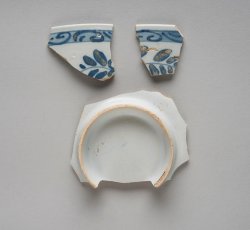Base, Body, Rim - Page 5 of 5

Large, rusticated white salt-glazed stoneware mug.
Stoneware | Object #: 1696153
Flared at base; two bands of rustication. Capacity estimated at 2.87 pints or almost a quart (using imperial measure).
Explore This Item
Slip-dipped cup (possible coffee or chocolate cup or capuchine).
Stoneware | Object #: 1696171
Explore This Item
Nottingham stoneware mug with incised "Y" on base.
Stoneware | Object #: 1696178
Though the rim diameter is slightly larger, the vessel probably measured 70mm in height, similar to 2573. Therefore, capacity estimated at 0.36 pints
Explore This Item
Buckley milk pan.
Coarse Earthenware | Object #: 1696185
This coarse earthenware milk pan, a shallow, straight-sided dish, sometimes with a spout and a rolled, everted, or reinforced rim, was used for cooling milk and separating cream. The black lead glaze and mixed yellow and red clay body are characteristic of Buckley, produced in western England. ...
Explore This Item
Nottingham stoneware slop bowl.
Stoneware | Object #: 1696186
Capacity: 0.73 imperial pints or about a pint.
Explore This Item

Nottingham stoneware zig-zag mug.
Stoneware | Object #: 1696235
Capacity estimated at 0.69 pints or about 1/2 a pint (using imperial measure).
Explore This Item
Rusticated Nottingham stoneware mug.
Stoneware | Object #: 1696259
Capacity estimated at 1.49 pints or about 1 1/2 pints (using imperial measure).
Explore This Item
Nottingham stoneware slop bowl.
Stoneware | Object #: 1696294
Capacity: 0.71 imperial pints or about a pint.
Explore This Item
Staffordshire slipware trailed and combed dish with pie crust rim.
Coarse Earthenware | Object #: 1722299
This fragment is a ceramic archaeologists refer to as North Midlands/Staffordshire type slipware. The word “type” is used here to denote the fact that coarse, slip decorated wares were actually produced in several regions of England throughout the seventeenth and eighteenth century. One feature...
Explore This Item
Blue painted tin-glazed earthenware punch bowl.
Refined Earthenware | Object #: 1722581
These are fragments of a tin-glazed earthenware punchbowl, with a hand painted botanical band adorning the exterior rim. This ware is often referred to by archaeologists as delftware. The white coloration of the glaze was obtained by adding tin-oxide to a lead glaze. Against this white field, d...
Explore This Item
Tin-glaze earthenware drug jar/ salve pot.
Refined Earthenware | Object #: 1722797
This is a fragment from the base of a tin-glazed earthenware drug jar. This ware is often referred to by archaeologists as delftware. The white coloration of the glaze was obtained by adding tin-oxide to a lead glaze. Against this white field, delft was most often decorated with hand painted co...
Explore This Item
White salt glaze stoneware teabowl.
Stoneware | Object #: 1725208
Almost complete teabowl.
Explore This Item
White salt glaze stoneware dot, diaper, and basket molded plate.
Stoneware | Object #: 1726033
This fragment of white salt glazed stoneware is a portion of a plate rim decorated by press molding. This white bodied ceramic was produced by combining naturally white clays with ground and calcined flint. In the process of press molding, clay sheets were pressed into block molds to form both ...
Explore This Item